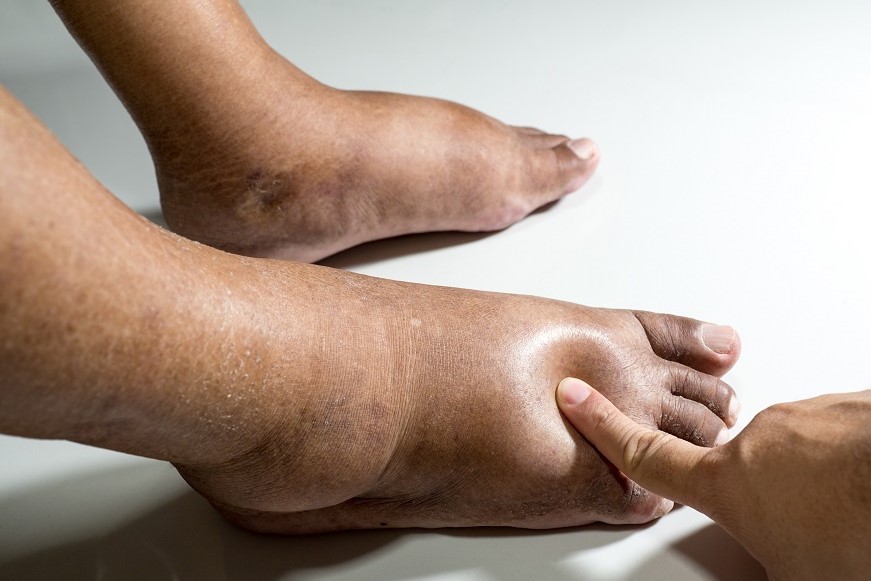
The classification of lymphoedema
Lymphoedema is a pathology that affects the lymphatic vessels and causes an accumulation of fluid and other substances in the intercellular spaces
The circulation of the lower limbs consists of three systems: arterial, venous and lymphatic
Arteries bring oxygenated blood and nutrients to the tissues, veins carry away blood rich in carbon dioxide and tissue breakdown products, and lymphatic vessels drain water and excess large molecules, proteins in particular, that occupy the spaces between cells.
Lymphatic vessels also perform an important defensive function against bacteria and pathogens in general.
Grades of lymphoedema classification
Lymphoedema of the lower limbs is a pathology that affects the lymphatic vessels.
Many pathogenic causes, both congenital and acquired, can lead the lymphatic vessels to fail to perform their function with accumulation of fluid and then substances in the intercellular spaces.
It can be distinguished into three basic degrees:
- the first consists of the simple accumulation of water leading to oedema of the lower limbs. This swelling is initially transitory, reducible and unlikely to cause major discomfort; symptoms may be blurred and confused with other pathologies: occasional cramping, especially at night, tingling, sometimes itching.
- The second stage is the one in which, along with water, proteins and other cell catabolites also stagnate. In this stage the oedema is more difficult to reduce and the symptoms (heaviness, tingling, cramping, itching) become persistent and constant, especially at night.
- the third degree corresponds to the indurative state of the subcutaneous tissue, when, as a result of constant and persistent stagnation, the organism produces fibrosis of the tissue; at this stage, oedema is no longer reducible and all therapeutic measures are only partially effective; the highest degree of lymphoedema corresponds to this stage, which is called elephantiasis.
Diagnosis and possible complications of lymphoedema
Complications, generally infectious, can always be added to these degrees.
Erysipelas is the most frequent and consists of a subcutaneous infection that causes a dermatitis, sometimes bullous, difficult to eradicate, often relapsing, marked by febrile episodes with chills, reddening of the skin, intense and vivid pain of the affected area with the appearance of lymphangitic streaks along the lymph node stations of the lower limb.
This infection aggravates the lymph stasis making the swelling and symptoms even more intense.
Chronic dermatitis with permanent sequelae also often remains.
The diagnosis is essentially clinical and should not be confused with stasis of venous origin (varices, post-thrombotic syndromes), which are often associated.
Nor should lymphoedema be confused with all those oedemas resulting from postural deficits of the foot (flatness, hallux valgus) and which are an expression of insufficient muscle pumping.
Other oedemas of cardiac, renal or protein origin must also be excluded.
Certain tumour pathologies, which can be the cause of lymphoedema, must also be excluded (lymphomas, lymph node metastases of other tumours).
Essential instrumental examinations are an echocolordoppler, to rule out a venous pathology, and some blood tests.
A lymphography is rarely necessary and is prescribed when surgical treatment is essential.
Prevention as the first real therapy
Therapy is simple for the first two degrees, difficult for the third.
It is always necessary to reduce oedema (pressotherapy, lymph drainage, adequate diet) and keep the limbs deflated (elastic stockings).
In the second and third degrees, heat therapy, mesotherapy and other more specific drugs can also be combined.
A series of tips, useful for venous insufficiency, are indispensable in the treatment of lymphoedema.
In the most extreme degrees, one must resort to investigative surgery, the results of which are not always optimal.
The real therapy is prevention, aimed especially at those patients who have a positive family history of lymphoedema.
All the necessary devices must be put in place to keep the legs deflated (pressure therapy, mesotherapy, lymphatic drainage, elastic stockings, orthotics) from the first complaints, to avoid an inexorable worsening of the situation to extreme degrees.
Read Also:
Emergency Live Even More…Live: Download The New Free App Of Your Newspaper For IOS And Android
Sentinel Lymph Node Technique: What It Is, What It Is Used For
Lymphadenitis: Symptoms, Diagnosis, Treatment And Prevention Of Lymph Node Infection
Lymphoma: 10 Alarm Bells Not To Be Underestimated
Non-Hodgkin’s Lymphoma: Symptoms, Diagnosis And Treatment Of A Heterogeneous Group Of Tumours
CAR-T: An Innovative Therapy For Lymphomas
Lymphangiomas And Lymphatic Malformations: What They Are, How To Treat Them
Lymphadenomegaly: What To Do In Case Of Enlarged Lymph Nodes
Swollen Lymph Nodes: What To Do?
Enlarged Lymph Nodes: The Causes Of Lymphadenopathy


